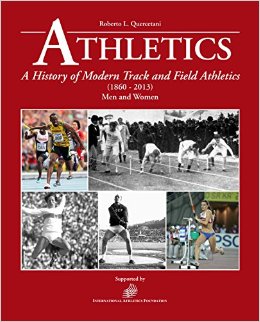
We asked Jeff Benjamin, a long-time contributor to American Track & Field and RunBlogRun, to review the magnum opus of our sport, Athletics-A History of Modern Track and Field Athletics by Roberto L. Quertecani.
Book Review of Athletics-A History of Modern Track and Field Athletics by Roberto L. Quertecani
By Jeff Benjamin
If there has ever been a “Great Sage” whose writings have influenced the world about the impact which Track and Field has had upon us, then Roberto L. Quercetani most definitely fits this description. An international journalist, records-keeper (He was one of the founders and the first President of the Association of Track and Field Statisticians) Quercetani’s writings have covered the sport for more than 3/4 of a century. In 1964, Quercetani wrote his first world history of athletics, which included a foreward by Harold Abrahams! Throughout the following years other book pertaining to athletics have flowed from his pen, covering almost every aspect , usually from a historical perspective, of the Sport to which Quercetani has devoted his life. Now in his updated edition of his masterpiece “Athletics – A History of Modern Track and Field (1860-2013) the author’s devotion to the grand stories and champions of Athletics, along with painstakingly listed statistical data, shows that his passion is as strong as ever.
After a brief opening of the world’s gradual changes in track and field dating back to ancient times, Quercetani makes the starting point of Athletics modernity 1860, with the setting in European countries. In the subsequent chapters, the author makes the chapters cover a 20 year period for the most past. But what is real good about this book is his categorization of the different events. So if the reader is just not into the sprints category, they can easily move on and read about the middle distances, long distances, field events, and even the racewalking categories during that particular era. So, the reader is exposed to the accomplishments of Sprinter George Seward, middle distance runner Thomas Conneff, Marathon Champion Spiridon Louis, hurdler Godfrey Shaw, or Field athlete Robert Garrett, or even racewalker Edward Payson Weston. It’s all there for you in your favorite category.
As the book progresses through the 1920-1940 eras, very popular champions include, not surprisingly Jesse Owens, Paavo Nurmi, , Earl Thomson, among others. But equal recognition is given to Ugo Frigerio as well! The following 1940-1960 consists of the exploits of Harrison Dillard, Bob Richards, along with the Gunder Hagg-Arne Anderson duels which would set the stage for Roger Bannister. The long distances are also devoted to Emil Zatopek, and once again, Quercetani gives equal recognition to the other events, including triple jumper Jozef Schmidt.
As the book moves onto the more modern era of the last half of the 20th century, the author keeps to the same format. Al Oerter,, Sebastian Coe, Edwin Moses, Viktor Saneyev and Abdon Pamich are just a few chronicled as the book moves into the 80’s, 90’s and even the current times. From Said Aouita to Usain Bolt, Carl Lewis to David Rudisha, Moses Kiptanui to Liu Xiang, Quercetani’s passionate and precision described accomplishments make the book continue to come to life.
After the current day, Quercetani devotes his time to the rise of Women.
Using the starting point of 1900, the author geographically sets the stage of Vassar College as the first organized athletics events for women. Then the book soars once again chronologically and in their respective events. From Yevdokiya Vasilyeva to Wilma Rudolph, Grete Waitz, Iolanda Balas, Mary Decker-Slaney, Evelyn Ashford, Fiona May, Veronica Campbell-Brown, to name a few, Quercetani keeps their stories, along with many others alive as well.
Quercetani also does not shy away from the controversies of each era, whether it’s amateurism, professionalism, doping, or women’s rights, the author writes about it in a balanced perspective.
The other thing which begs mentioning is the authors little anectdotal stories which are sprinkled throughout the book. Whether from the athletes themselves, or article research, or evwen his own personal recollections of over 75 years of chronicling stories, these short pieces do a great job of reinforcing many stories that are already known.
One of my favorites is a short anecdote in which ‘Quercetani was able to dig up a news article where a reporter predicted that Roger Bannister would be the world’s first sub-4 minute miler. The amazing thing about this prophetic statement was that it was written in 1949, five years prior to the feat, and when Bannister was running around 4:16!! Only Quercetani could have found that one.
As you have read this review, I wouldn’t be surprised if some of you were unfamiliar with the names mentioned throughout it. All the more reason for any running track and field afficionado to buy this book. You’ll be glad you did!!
Larry Eder has had a 52-year involvement in the sport of athletics. Larry has experienced the sport as an athlete, coach, magazine publisher, and now, journalist and blogger. His first article, on Don Bowden, America's first sub-4 minute miler, was published in RW in 1983. Larry has published several magazines on athletics, from American Athletics to the U.S. version of Spikes magazine. He currently manages the content and marketing development of the RunningNetwork, The Shoe Addicts, and RunBlogRun. Of RunBlogRun, his daily pilgrimage with the sport, Larry says: "I have to admit, I love traveling to far away meets, writing about the sport I love, and the athletes I respect, for my readers at runblogrun.com, the most of anything I have ever done, except, maybe running itself." Also does some updates for BBC Sports at key events, which he truly enjoys. Theme song: Greg Allman, " I'm no Angel."
View all posts






















